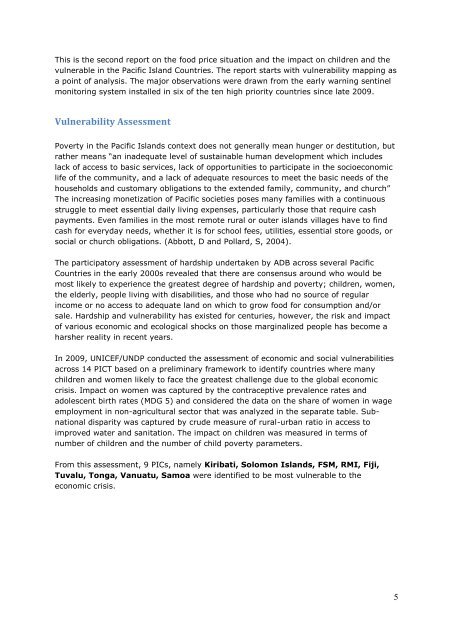Food Price Increases in the Pacific Islands - Unicef
Food Price Increases in the Pacific Islands - Unicef
Food Price Increases in the Pacific Islands - Unicef
Create successful ePaper yourself
Turn your PDF publications into a flip-book with our unique Google optimized e-Paper software.
This is <strong>the</strong> second report on <strong>the</strong> food price situation and <strong>the</strong> impact on children and <strong>the</strong><br />
vulnerable <strong>in</strong> <strong>the</strong> <strong>Pacific</strong> Island Countries. The report starts with vulnerability mapp<strong>in</strong>g as<br />
a po<strong>in</strong>t of analysis. The major observations were drawn from <strong>the</strong> early warn<strong>in</strong>g sent<strong>in</strong>el<br />
monitor<strong>in</strong>g system <strong>in</strong>stalled <strong>in</strong> six of <strong>the</strong> ten high priority countries s<strong>in</strong>ce late 2009.<br />
Vulnerability Assessment<br />
Poverty <strong>in</strong> <strong>the</strong> <strong>Pacific</strong> <strong>Islands</strong> context does not generally mean hunger or destitution, but<br />
ra<strong>the</strong>r means “an <strong>in</strong>adequate level of susta<strong>in</strong>able human development which <strong>in</strong>cludes<br />
lack of access to basic services, lack of opportunities to participate <strong>in</strong> <strong>the</strong> socioeconomic<br />
life of <strong>the</strong> community, and a lack of adequate resources to meet <strong>the</strong> basic needs of <strong>the</strong><br />
households and customary obligations to <strong>the</strong> extended family, community, and church”<br />
The <strong>in</strong>creas<strong>in</strong>g monetization of <strong>Pacific</strong> societies poses many families with a cont<strong>in</strong>uous<br />
struggle to meet essential daily liv<strong>in</strong>g expenses, particularly those that require cash<br />
payments. Even families <strong>in</strong> <strong>the</strong> most remote rural or outer islands villages have to f<strong>in</strong>d<br />
cash for everyday needs, whe<strong>the</strong>r it is for school fees, utilities, essential store goods, or<br />
social or church obligations. (Abbott, D and Pollard, S, 2004).<br />
The participatory assessment of hardship undertaken by ADB across several <strong>Pacific</strong><br />
Countries <strong>in</strong> <strong>the</strong> early 2000s revealed that <strong>the</strong>re are consensus around who would be<br />
most likely to experience <strong>the</strong> greatest degree of hardship and poverty; children, women,<br />
<strong>the</strong> elderly, people liv<strong>in</strong>g with disabilities, and those who had no source of regular<br />
<strong>in</strong>come or no access to adequate land on which to grow food for consumption and/or<br />
sale. Hardship and vulnerability has existed for centuries, however, <strong>the</strong> risk and impact<br />
of various economic and ecological shocks on those marg<strong>in</strong>alized people has become a<br />
harsher reality <strong>in</strong> recent years.<br />
In 2009, UNICEF/UNDP conducted <strong>the</strong> assessment of economic and social vulnerabilities<br />
across 14 PICT based on a prelim<strong>in</strong>ary framework to identify countries where many<br />
children and women likely to face <strong>the</strong> greatest challenge due to <strong>the</strong> global economic<br />
crisis. Impact on women was captured by <strong>the</strong> contraceptive prevalence rates and<br />
adolescent birth rates (MDG 5) and considered <strong>the</strong> data on <strong>the</strong> share of women <strong>in</strong> wage<br />
employment <strong>in</strong> non-agricultural sector that was analyzed <strong>in</strong> <strong>the</strong> separate table. Subnational<br />
disparity was captured by crude measure of rural-urban ratio <strong>in</strong> access to<br />
improved water and sanitation. The impact on children was measured <strong>in</strong> terms of<br />
number of children and <strong>the</strong> number of child poverty parameters.<br />
From this assessment, 9 PICs, namely Kiribati, Solomon <strong>Islands</strong>, FSM, RMI, Fiji,<br />
Tuvalu, Tonga, Vanuatu, Samoa were identified to be most vulnerable to <strong>the</strong><br />
economic crisis.<br />
5

















